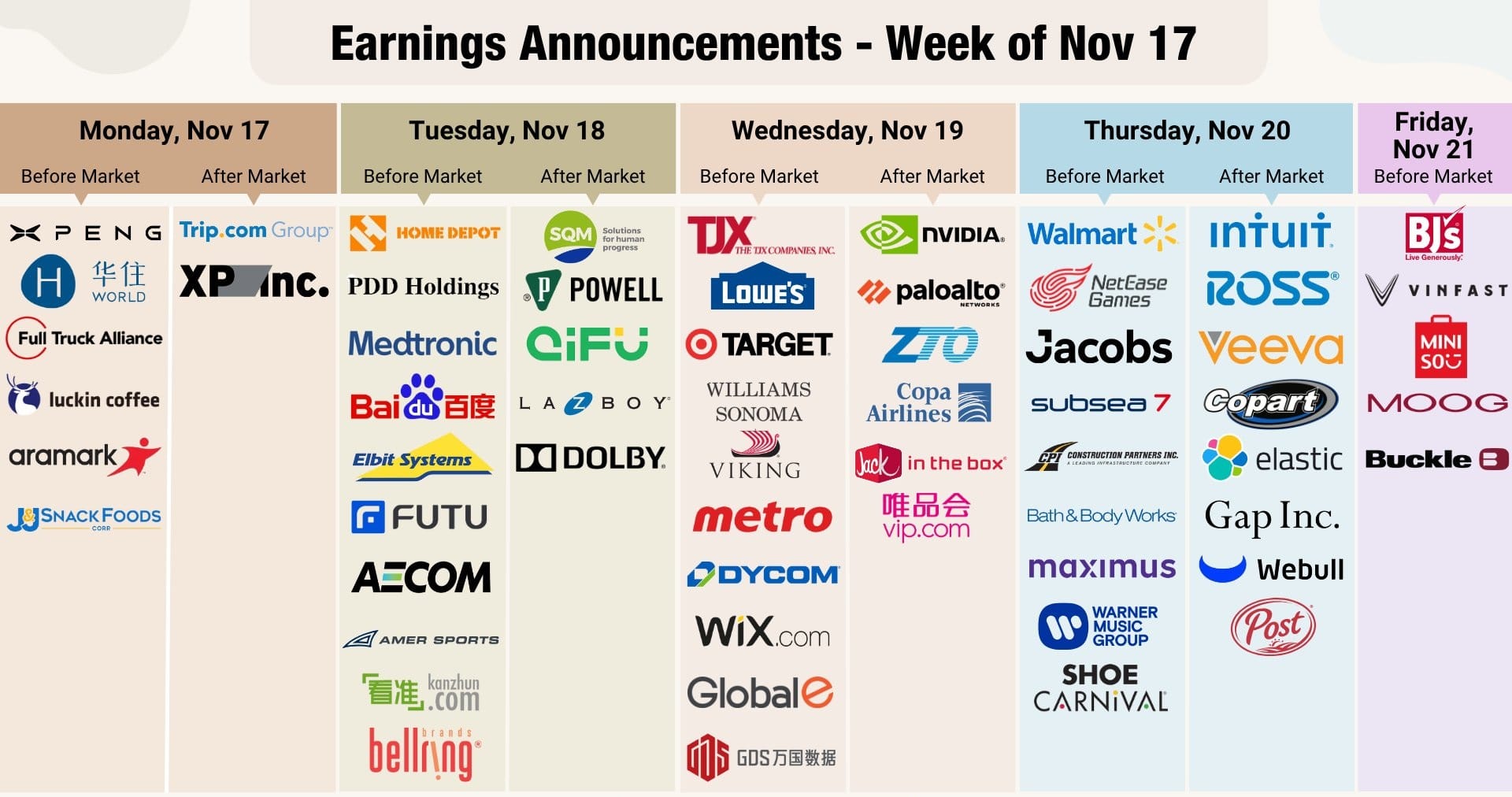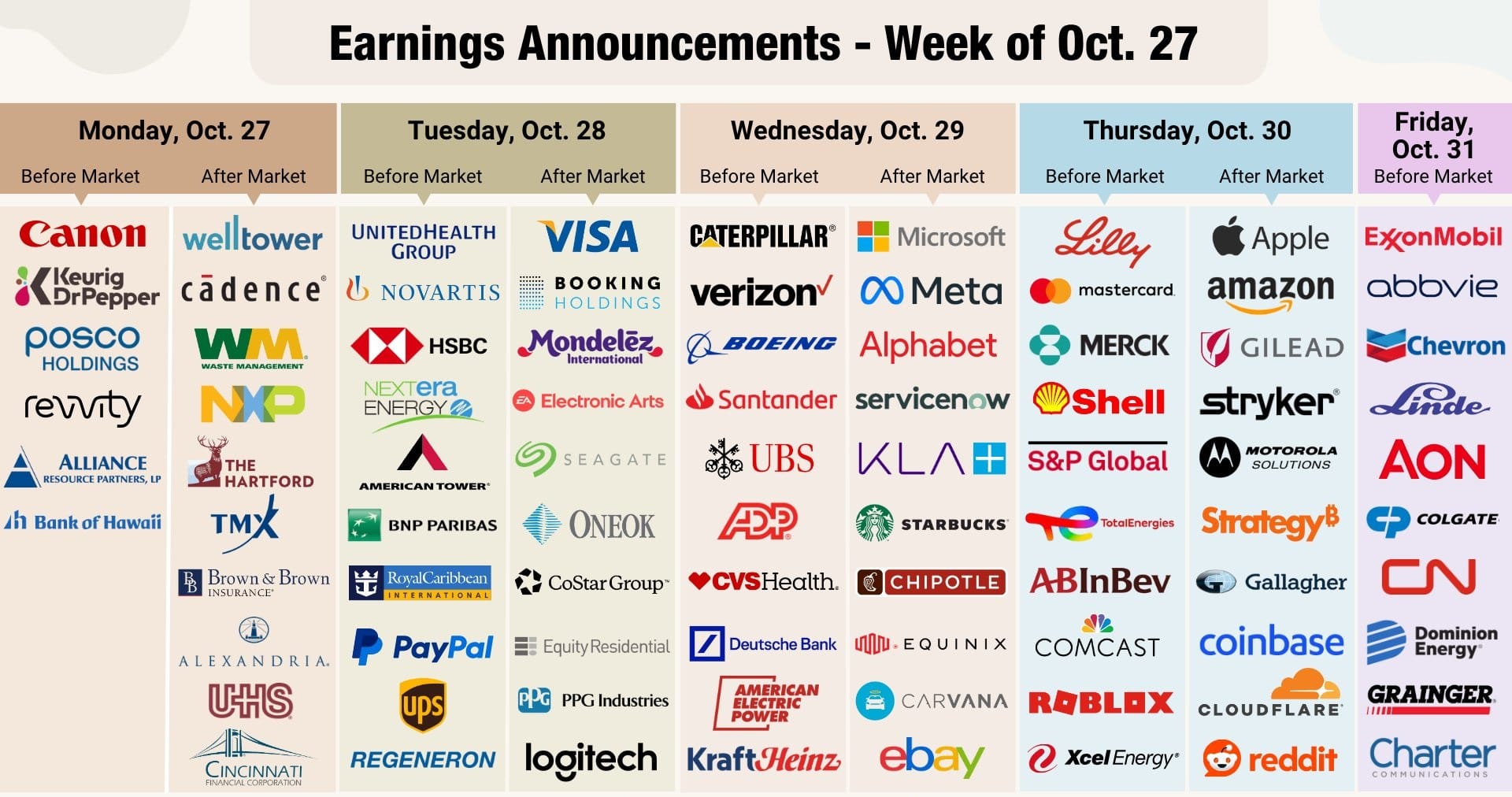Section 1: The Heart of the Storm — Earnings Season Takes Center Stage
Earnings Season has arrived at a moment of extraordinary convergence in global markets. In the final week of October 2025, the financial world’s attention turns not just to the numbers companies report but to the narratives they reinforce. It is a period when the profit statements of the world’s most valuable firms become reflections of deeper economic forces — consumer resilience, interest rate dynamics, and the fragile equilibrium between growth and inflation.
The coming days will bring results from corporate heavyweights that collectively define the market’s direction: Meta Platforms, Microsoft, Alphabet, Amazon, and Apple. Together, these firms represent the heartbeat of global innovation, and their reports will shape both sentiment and sector rotation across asset classes.
Meta Platforms (META) — The AI Monetization Test
Consensus: EPS $6.61 | Revenue $49.34B
Meta enters this Earnings Season with a reputation for operational discipline but faces growing scrutiny over whether efficiency gains can sustain growth in a slower ad market. After the celebrated “Year of Efficiency,” the focus has shifted toward AI-driven advertising, user engagement, and cost management within Reality Labs.
Investors will watch whether Meta can continue expanding Average Revenue Per User (ARPU) while navigating a softening global advertising environment. Any hint of deceleration in digital ad spend could weigh heavily on sentiment, particularly if macro data reinforces slower consumer activity.
A dovish Fed could provide relief here, as lower yields improve valuation multiples for long-duration tech assets — a dynamic that could help Meta’s stock rebound even amid margin compression.
Microsoft (MSFT) — The AI Integration Benchmark
Consensus: EPS $3.65 | Revenue $74.96B
Microsoft remains the sector’s most stable fortress. Its Azure cloud division continues to anchor growth, while the rollout of Copilot AI across Office 365, GitHub, and Dynamics marks a structural transformation in enterprise productivity.
In this Earnings Season, investors are asking whether AI integration is already contributing materially to revenue. If Azure’s constant-currency growth holds steady or accelerates, it will confirm that corporate digital transformation spending remains intact — a bullish signal for broader business confidence.
A strong showing would also support the thesis that productivity-focused AI adoption, rather than consumer discretionary demand, is driving the next wave of tech investment.
Alphabet (GOOGL) — Search Dominance Under Pressure
Consensus: EPS $2.27
For Alphabet, this Earnings Season is less about beating numbers and more about demonstrating adaptability. As the digital advertising market evolves and AI search integration accelerates, investors will assess how effectively Google’s Gemini model enhances monetization across Search, YouTube, and Cloud.
The key question is whether Google Cloud can maintain profitability momentum after turning the corner earlier this year. A slowdown could hint at tightening corporate IT budgets — a critical macro signal for investors gauging the health of enterprise spending.
YouTube’s performance, especially in shorts monetization and premium subscriptions, will also act as a proxy for consumer engagement during a time of restrained discretionary spending.
Amazon (AMZN) — The Profitability Reawakening
Consensus: EPS $1.57 | Revenue $177.96B
Amazon’s transformation from a high-growth disruptor to a disciplined profit generator continues. After years of capital-heavy expansion, the company’s logistics optimization and regional fulfillment model are driving cost efficiencies. Meanwhile, AWS (Amazon Web Services) remains a critical bellwether for corporate cloud spending.
The story this Earnings Season will hinge on margin expansion — whether e-commerce operating income can rise in tandem with AWS reacceleration. Amazon’s advertising segment, often overlooked, is also emerging as a vital contributor to profit growth, now competing head-to-head with Meta and Google.
A robust report would signal resilience in global consumer demand and business technology investment, even amid geopolitical uncertainty and slowing global trade.
Apple (AAPL) — The Global Consumer Barometer
Consensus: EPS $1.73 | Revenue $101.27B
For Apple, every Earnings Season becomes a referendum on global consumer strength. This quarter, however, the narrative extends beyond product cycles. Apple’s performance is intertwined with geopolitics: supply chain continuity in China, consumer sentiment in emerging markets, and trade negotiations between Washington and Beijing.
The Services division, encompassing App Store, iCloud, and Apple Music, continues to be Apple’s profit engine. Growth here offsets flatlining iPhone volumes. However, escalating tariff threats and potential disruptions to Chinese assembly lines could reshape forward guidance.
Investors will monitor Greater China revenue and gross margin trends closely — numbers that double as a barometer for U.S.-China relations.

Section 2: Policy Crosscurrents — Central Banks at a Crossroads
While corporate America releases its report cards, central banks are scripting the next chapter in monetary history. The Federal Reserve’s policy decision, scheduled for Wednesday, will define the macro backdrop for the rest of 2025.
Federal Reserve — The Tightrope Act
Event: FOMC Policy Announcement
Consensus: 25bps cut to 3.75–4.00%
The Fed finds itself navigating between softening labor markets and stubbornly high core inflation. A 25 basis-point rate cut is widely expected, but the substance lies in the forward guidance.
If Chair Powell signals a pause in Quantitative Tightening (QT) or a dovish bias toward additional cuts, it would reaffirm the market’s pivot toward risk assets. Conversely, any hint of a “one-and-done” approach could strengthen the dollar and suppress equity valuations, particularly in rate-sensitive tech and real estate sectors.
Investors will also parse updates to the dot plot, especially revisions to the neutral rate — a parameter that shapes asset valuation for years to come.
Global Central Banks: Divergent Paths
- European Central Bank (ECB) is expected to hold at 2.00%, balancing fragile growth with inflation risks. Christine Lagarde’s tone on the Transmission Protection Instrument (TPI) will matter for European credit spreads.
- Bank of Japan (BoJ) remains the global outlier, maintaining rates at 0.50% as new leadership prioritizes policy continuity amid political uncertainty.
- Bank of Canada (BoC) may follow the Fed with a 25bps cut amid deteriorating trade relations and a darkening export outlook.
Together, these moves illustrate a fragmented global policy environment, where liquidity injections in the U.S. contrast with cautious neutrality in Asia and Europe.
Section 3: Geopolitics and Global Equilibrium
The macroeconomic stage this week extends beyond interest rates. U.S.-China diplomacy and trade negotiations loom large, influencing not just currency markets but also corporate forecasts and supply chain strategies.
U.S.-China Dialogue — Between Truce and Tension
The potential Trump–Xi meeting during the APEC summit could define risk sentiment. The current trade truce, set to expire November 10, hangs in the balance. Any escalation—such as the threatened 100% tariffs on Chinese goods—could reverberate through technology, agriculture, and manufacturing sectors.
A joint communiqué emphasizing cooperation would trigger a relief rally, benefiting high-exposure firms like Apple, Tesla, and Nvidia. Conversely, a breakdown in talks could trigger risk aversion, boosting gold, the dollar, and Treasuries.

Market Implications of Diplomatic Outcomes
| Scenario | Market Reaction | Beneficiaries |
|---|---|---|
| De-escalation / Truce Extension | Risk-on rally in equities and commodities | AAPL, NVDA, ADM, Emerging Markets |
| Breakdown / Tariff Escalation | Global sell-off, flight to quality | USD, Gold, U.S. Treasuries |
| Status Quo / Continued Talks | Volatile sideways movement | Mixed sector rotation |
Section 4: Economic Pulse — Data Releases Framing the Narrative
U.S. Q3 GDP & PCE Inflation
If government data releases proceed despite the ongoing shutdown, markets expect robust Q3 GDP growth near 3.9% and a potential moderation in core PCE inflation.
A soft inflation print could validate dovish monetary bets, whereas a hotter reading could reignite volatility across fixed income and equities.
Global Data Highlights
- Australia’s CPI (Wednesday): Forecast +1.1% QoQ; higher readings could delay RBA rate cuts.
- Eurozone Flash HICP (Friday): Early inflation signals for December’s ECB decision.
- China PMIs (Friday): Critical barometer for industrial demand post-trade talks.
Each release contributes to the mosaic shaping risk appetite — whether the narrative remains one of “resilient slowdown” or transitions toward “policy-induced recovery.”

Section 5: Strategic Synthesis — Reading the Intersections
This week’s Earnings Season is not an isolated event but a mirror reflecting broader global dynamics. The interaction of corporate earnings, central bank policy, and geopolitics produces a matrix of potential outcomes.
Scenario 1: The “Goldilocks” Outcome
- Fed delivers dovish cut
- U.S.-China truce extended
- Tech earnings broadly beat
Market Reaction: Broad rally led by growth stocks. USD softens, emerging markets and semiconductors outperform.
Scenario 2: The “Stagflationary” Twist
- Hawkish Fed tone
- Inflation sticky
- Mixed corporate guidance
Market Reaction: Rotation into value and defensives. Yields edge higher, volatility persists.
Scenario 3: The “Risk-Off” Shock
- Fed holds rates citing inflation risks
- Trade talks collapse
- Tech earnings disappoint
Market Reaction: Global equity correction. Capital flows into Treasuries, gold, and the Japanese yen.
Section 6: Strategic Outlook — Positioning for the Weeks Ahead
For professional investors, this week represents a rare confluence of catalysts. The intersection of monetary policy, geopolitical diplomacy, and Earnings Season performance offers insights that extend beyond short-term volatility.
- Tech Leadership: Sustained only if guidance confirms durable AI monetization and capex discipline.
- Dollar Direction: Hinges on the Fed’s tone — dovish means weaker USD and stronger risk sentiment.
- Sector Rotation: Watch for shifts toward cyclicals if growth narratives strengthen.
- Bond Market: Sensitive to QT commentary and inflation data — any pause in runoff would extend duration bids.
Ultimately, the 2025 market narrative hinges on one question: whether this Earnings Season reinforces the view that corporate America remains the engine of global growth, or whether policy uncertainty and geopolitical friction start to erode that confidence.












